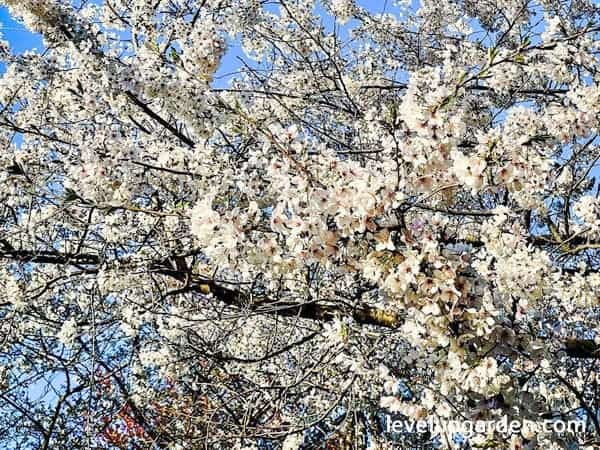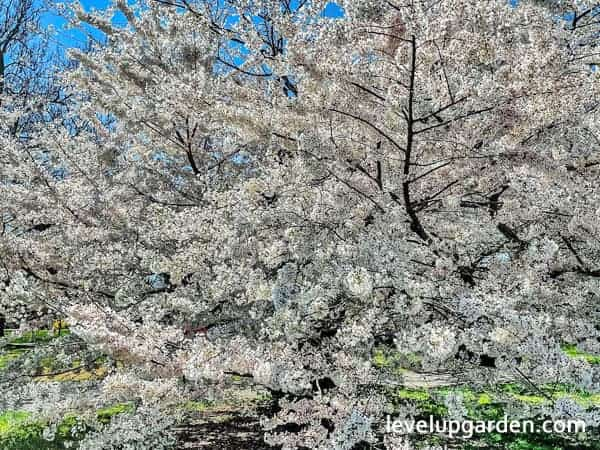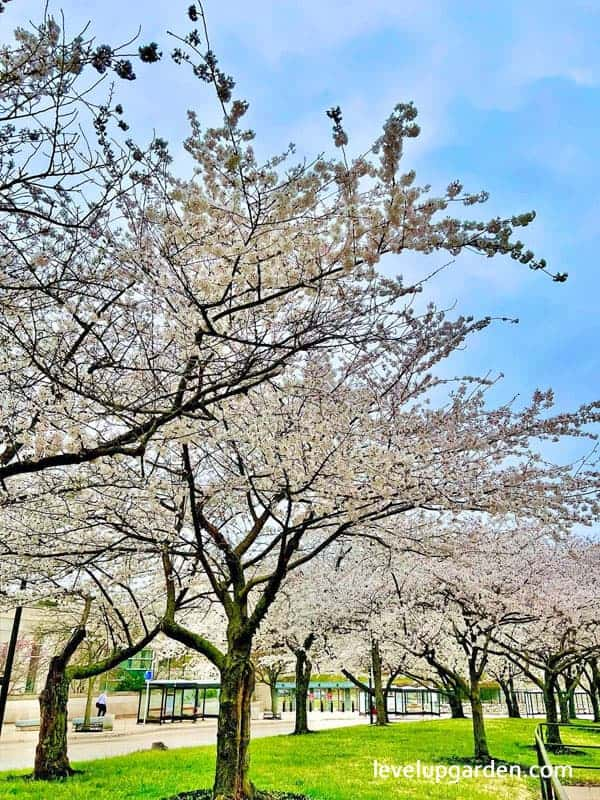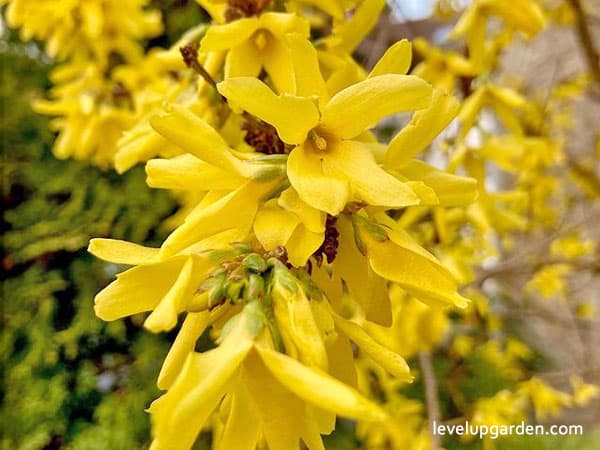White Dogwood (Cornus florida) is a large shrub or small deciduous tree with a rounded to flat canopy adorned with graceful horizontal or stepped branches that can be enjoyed in all seasons. It is a magnificent landscape tree, considered by many gardeners to be “one of the best small flowering trees. Read on to learn about White Dogwood’s profile, appearance, growing conditions, and uses.
Dogwood is a flowering tree of the dogwood family native to eastern North America and northern Mexico. It was once endemic from the southernmost coast of Maine to northern Florida and west to the Mississippi River. Because of the beauty of its bracts and the interesting structure of its bark, it is generally planted as an ornamental in residential areas and public buildings.

I. White Dogwood Profile – An Overview of the plant
| Common Name | White Dogwood, Flowering Dogwood, American Box, Blood Twig Dogwood, Common White Dogwood, Eastern Flowering Dogwood, False Box Wood, North American Green Osier |
| Botanical Name | Cornus florida |
| Plant Type | Shrubs, Trees |
| Plant Family | Cornus – Dogwoods |
| Exposure | Full Sun, Partial Sun |
| Height | 15′ – 25′ |
| Spread | 15′ – 25′ |
| Water Needs | Average |
| Maintenance | Low |
| Soil Type | Clay, Loam, Sand |
| Soil pH | Acid, Neutral |
| Soil Drainage | Moist but Well-Drained, Well-Drained |
| Growth Rate | 1-2 ft. |

II. White Dogwood Appearance
The white dogwood has a beautiful rounded, umbrella-like shape. In spring, before the foliage has grown thick, it produces a profusion of star-like flowers, 7-10 cm across. Four narrow, pointed white bracts surround a small central cluster of green flowers.
In summer, rounded orange fruits are produced, which remain until late in the year unless eaten by birds. In summer, the plant produces oval, medium green leaves on multiple layers of branches, providing shade and beauty.
In fall, the leaves turn purple and scarlet, and the foliage is brilliantly red. The bark is light gray and smooth when young, but as it matures it turns grayish-brown and develops a distinctive alligator-skin-like pattern that adds interest to the winter landscape. In winter, look out for the silvery bark.
Dogwood trees grow to 15-25 feet tall with a spread of 20-25 feet. The growth rate is slow, about 1-2 feet per year.

III. White Dogwood Growing and Care Conditions
The white dogwood is a beautiful harbinger of spring. This flowering ornamental tree grows well in a wide range of soils and climates in USDA zones 5-8. It grows in nearly all soils, from clay to loam, and can tolerate moist and well-drained soils.
- Planting: It can grow in full sun, but prefers shade. In addition to its spring flowers, its fall foliage and bright red winter berries are attractive and attract many wildlife species. Choose a bright or filtered shade location for planting dogwoods.
- Sun Exposure: White dogwood grows well in partial shade, called shade; it needs about four hours of direct sunlight per day.
- Watering: The roots of dogwood are very shallow and can easily dry out without regular rainfall. Watering once or twice a week is recommended. If the leaves are light green, water them correctly; if the leaves are drooping, they may be both over-and under-watered. If you are watering too much or too little, watch for these signs.
- Fertilizer: Flowering dogwoods are trees that do not require much fertilizer. When it does need fertilizer, it should be applied sparingly in April and May. Any common fertilizer will do.
- Soil Requirements: It can grow in clay and sandy soils and is adaptable to a wide range of soil conditions. However, it grows well in moist, loamy, slightly acidic soils. Its shallow roots need to be kept moist, but it does not like to get its feet wet.
- Pruning: White dogwoods grow in a round shape and do not need to be pruned to maintain it. If pruning is necessary for aesthetic reasons, it should be done in late fall or winter when the tree is dormant. Also, if you see dead, damaged, or diseased branches, prune them immediately.
- Pests and Diseases: Good soil, proper food, and healthy watering habits are essential for a tree to thrive. However, Dogwoods are susceptible to quite a number of diseases when stressed, the most serious of which is dogwood anthracnose. It is also susceptible to powdery mildew, leaf scorch, canker sores, root rot, leaf blight, and twig blight. Stressed trees are also susceptible to borers. Leafminers and beetles are less serious pests.
IV. White Dogwood Uses
Flowering dogwoods as specimens or small groups around homes, near patios, and on lawns. Also works well in woodlands, bird, and native plant gardens.
It is also ideal for planting around patios. Its low-growing branches provide an attractive backdrop for outdoor spaces while blocking wind and visibility. If you want to attract birds to your yard, dogwoods are the perfect plant.
V. Should you buy a White Dogwood? Is this the tree for your garden?
Each year, the dogwood tree is a beautiful sight with its clusters of delicate flowers around dark green foliage. In fall, the leaves turn deep scarlet and look different each month.

What’s even better, it’s versatile. It grows perfectly as the centerpiece of the landscape and does not need an accompanying tree to make a statement. Plus, its compact size makes the white confetti a great choice for planting along roadsides, near large buildings, next to patios, and along property lines.
The dogwood tree has easily grown in average, medium moisture, with well-drained soil in sun to shade. It prefers shady, acidic soils rich in organic matter; 2-4 inches of mulch will keep the roots cool and moist throughout the summer. Planting this tree in areas where dogwood anthracnose is endemic is not recommended at this time.
White dogwoods are small trees, usually less than 20 to 30 feet tall. This makes them ideal for small yards or in tight spots near patios and decks.
Alone as an illuminated specimen tree or in groups, they can be used to show off the impact of their vibrant colors and what this tree has to offer throughout the four seasons.
White dogwoods should be planted against a backdrop of evergreens such as Thuja Green Giant. It provides a stunning contrast.
Do you think this is the tree for your garden?
VI. FAQs
Are White Dogwoods fast-growing?
White Dogwood trees grow to 15-25 feet tall with a spread of 20-25 feet. The growth rate is slow, 1-2 feet per year.
How tall is a White Dogwood tree?
The White Dogwood grows to about 25 feet tall at maturity, with a spread of about 25 feet.
Are White Dogwoods good trees?
White Dogwoods are spectacular ornamental trees that are well suited for life in the United States. Just like any other plant, give it plenty of water and sunlight and it will do fine.







